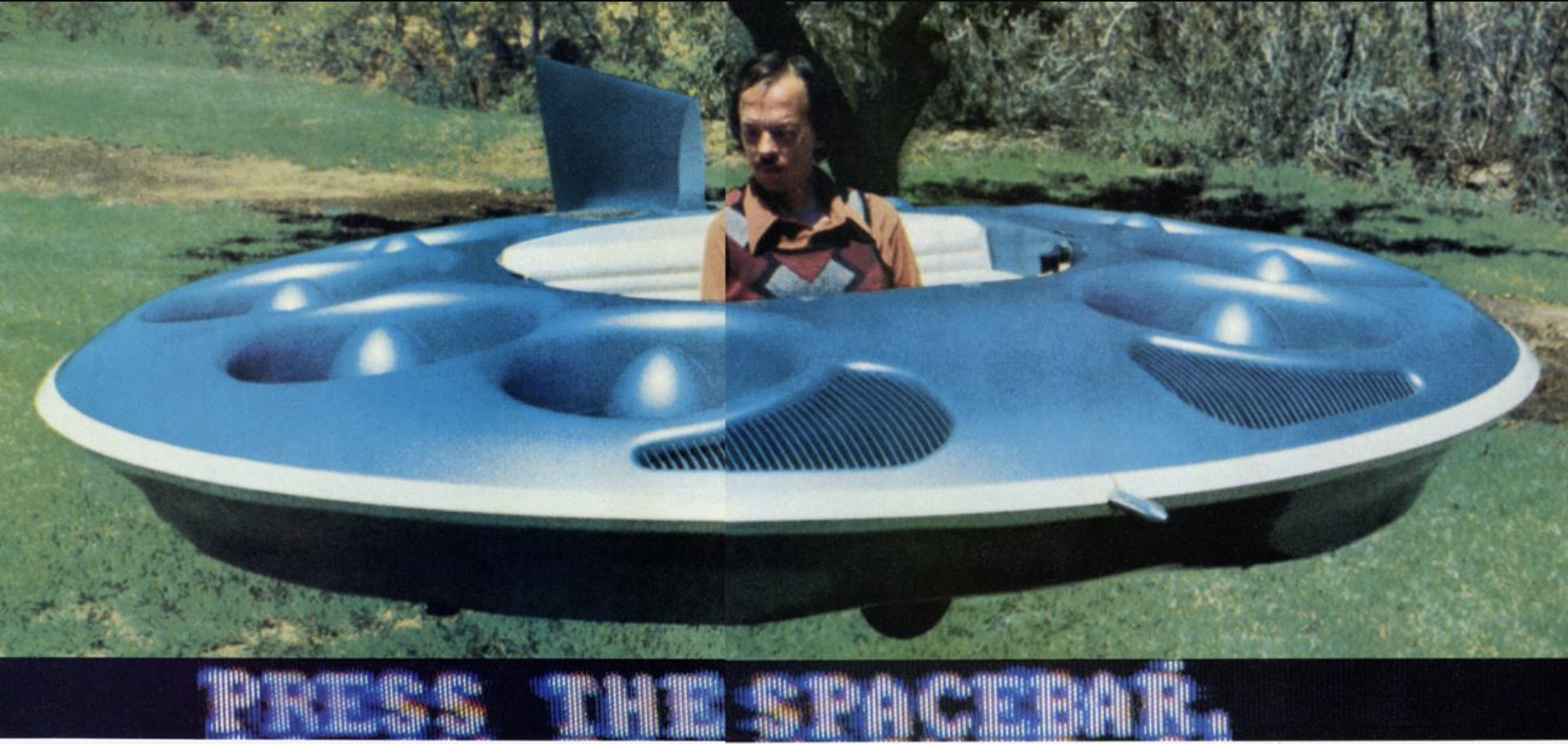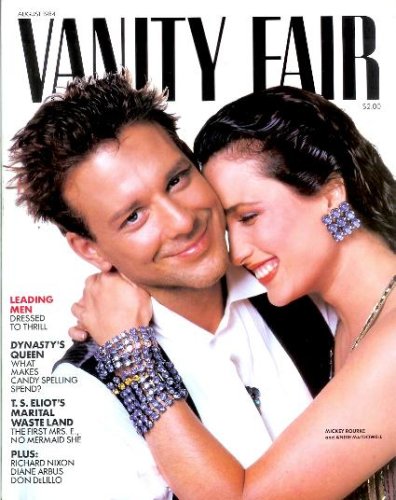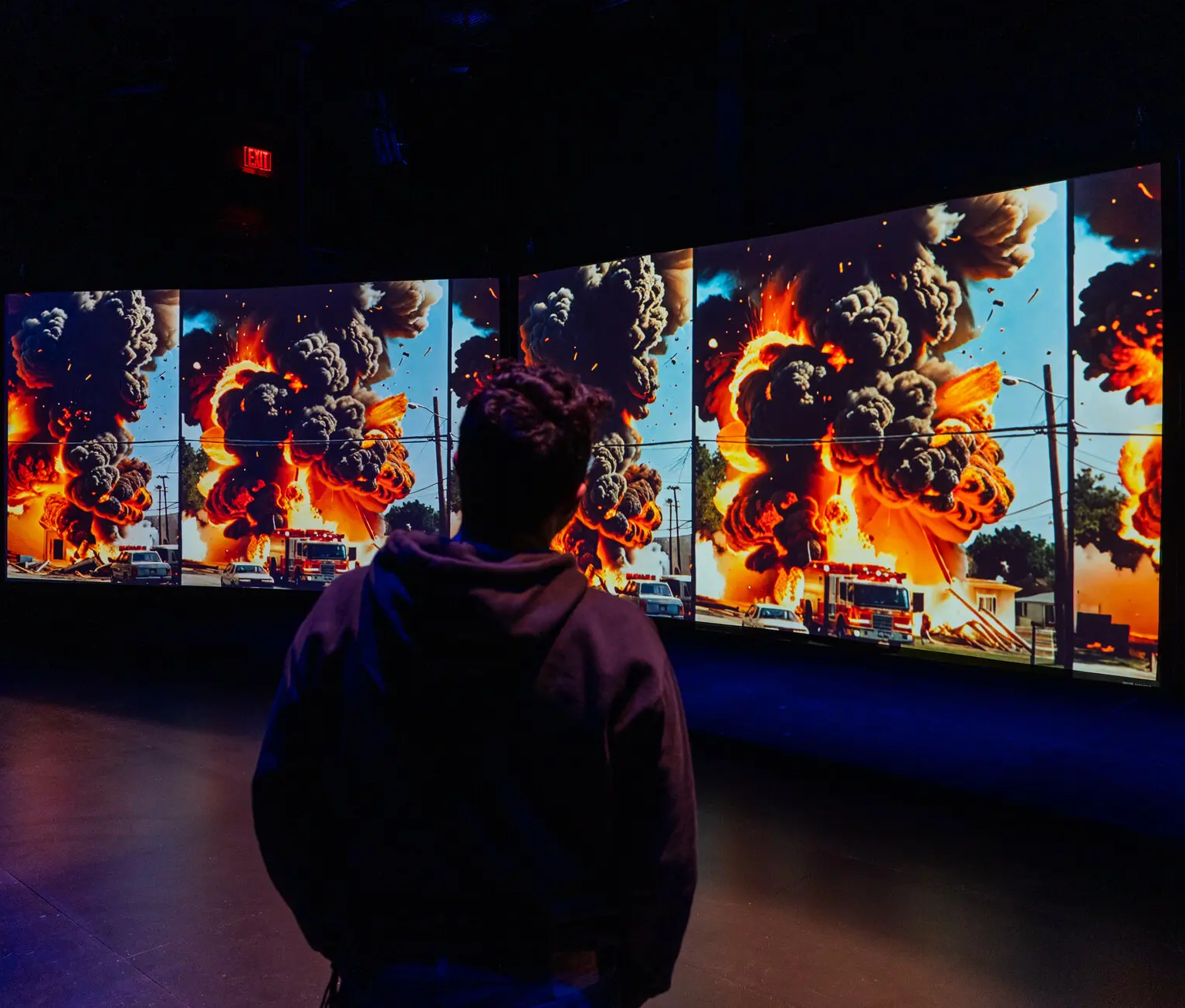
“I WANT A NEW DRUG!” shouts the singer of the hit tune of the same name. Well, in a small city in Northern California, they’ve found one. The city is Santa Cruz, and the drug is computer technology. It’s not something you can smoke, but it can do weird things to your head all the same. That’s because it’s laced with “information”—digital data with mind-expanding capabilities. And information is supposed to be the key to a whole new world, a mystical universe where magic comes alive.
 If all this is true, then the computer might be some sort of philosophers’ stone, an alchemical tool that will transmute baser consciousness into gold. That would mean the folks here in Santa Cruz are harbingers of still another New Age—the Information Age, in which humans will finally realize the power that lives within them. But could these motley souls be the “anticipatory citizens” Alvin Toffler wrote about in The Third Wave? I decided to beam down and find out.
If all this is true, then the computer might be some sort of philosophers’ stone, an alchemical tool that will transmute baser consciousness into gold. That would mean the folks here in Santa Cruz are harbingers of still another New Age—the Information Age, in which humans will finally realize the power that lives within them. But could these motley souls be the “anticipatory citizens” Alvin Toffler wrote about in The Third Wave? I decided to beam down and find out.
THE SLUICEWAY FROM THE PIT sends you down a neon alley headed straight for the Boardwalk—Highway 17 to Ocean Street and whoosh! you’re on the beach, with sand underfoot and palm trees overhead. This used to be mostly a surfer town, and before that it was where the old folks retired, but for more than a decade now it’s been a haven for hippies. Santa Cruz, California: Where the tribes of the Rainbow Nation retreated after Altamont and Kent State and Jerry Rubin’s defection to Wall Street. Where a New Age is still struggling to be born amid the detritus of the old. Where the street people howl and the cops seldom bite.
“I like to think of it as Oz,” said Earle Lane, a local resident.
Sixty miles south of Haight-Ashbury, at the top of Monterey Bay, Santa Cruz is shielded from the rest of California by high mountains and redwood forests. During the sixties an experimental branch of the University of California was established in the foothills above town, flooding it with humanities majors who didn’t want to leave. Rents were cheap and winters mild, so as the sixties faded and life grew harsher, Santa Cruz became a refuge for those who clung to the dream. But though they came with visions of a land of milk and honey, they found themselves scraping by on food stamps and mantras.
Meanwhile, just across the ridge, Silicon Valley was growing into a humming electronic web of freeways, shopping centers, ranch houses, and high-tech research parks. The Valley had everything that Santa Cruz didn’t—power, money, excitement, gadgets. Gradually, inevitably, its presence began to penetrate the time-capsule-by-the-sea. Fertilized by potent marijuana and seductive wines, both locally produced, a new culture emerged. This culture combined trippy spiritualism with a romantic faith in technology. Its members started talking about “the tech” that was emerging from “the Pit” as if it offered some sort of nirvana. They started “turning on” to the tech and discovered you could really get a buzz. Wow, they thought, those nerd guys over the hill are actually onto something.
A PRIME EXAMPLE OF THE TECH IN QUESTION was sitting in a dome on top of the mountains: it was an Apple II+ augmented by a dual-processor Godbout supermicro named Albert. The dome they were in looks south across the horizon to Monterey, with an imitation stained-glass mandala where the Third Eye would be. In the surrounding forests are the tree people, renegades who live in tree houses and abandoned cabins scattered up and down the precipitous slopes. Like the mall rats who panhandle in the Pacific Garden Mall downtown, the tree people are too far-out to need new highs. The dome’s residents, Allan Lundell and Geneen Haugen, feel bad for them. “These people are missing the space window,” Geneen said.
The daughter of a Honeywell executive, Geneen is a former systems engineer who quit to guide river rafts and live in a tepee in Wyoming before returning to the relative civilization of the Santa Cruz Mountains. Allan is a professional “networker” who studied environmental psychology at Antioch, developed a “theater of the future” at the 1982 US Festival, and was once an editor at Byte magazine. An intense young man with very straight blond hair, he now works with Mentor—a magazine that’s published not on paper but on a floppy disk. Like Geneen, he’s dedicated to the spread of what they call “evolutionary technology.”
There are a lot of people like Allan and Geneen in Santa Cruz—starry-eyed technocrats who want to make their visions real. Many of them work as programmers. The hardware comes over the hill from Silicon Valley, but what are you going to do with it? People here have plenty of ideas. By developing software for the big computer companies in the Pit, they have begun to turn those ideas into products that offer an alternative to the corporate mind-set. How much influence will they have? Ira Pohl, of the computer and information sciences department at U.C. Santa Cruz, thinks of them as a weather vane. “They’re not the future,” he said, “but they’re pointing at things that will be important in the future. “
Take the Sensonics Theater that Allan built for US, a three-day rockfest that was promoted as a sort of techie Woodstock. Sensonics consisted of an inflatable dome wired for 360-degree video projection and eight-channel sound. “We figured a 3-D theater could trigger a change in human consciousness,” Allan explained.
Changing consciousness was the whole idea behind US, which was put on by Steve Wozniak in the desert near San Bernardino. Wozniak, of course, is the millionaire co-inventor of the Apple, America’s first mass-produced personal computer. Sometimes Apple itself is viewed as something of a techie Woodstock; certainly Allan and Geneen regard their Apple as the near-magical embodiment of a frontier spirit. That’s how Apple would like to portray the situation. Part of its Macintosh campaign involved electronic press kits that showed a video image of Apple chairman Steve Jobs—California longhair, pioneer technocrat, entrepreneurial whiz kid—talking about the new machine in terms of dreams. “Most places in life are continually telling you your dreams aren’t possible,” he said. “You don’t want to hear that when you’re under thirty.”
Under thirty . . . that sounded familiar. The sixties. Drugs. Rock music. Computers. Of course. It was all coming back to me now.
“NO HOPE WITHOUT DOPE!” Stewart Brand laughed at the memory. It had been sixteen years since his Whole Earth Catalog had first offered “access to tools” to the Woodstock generation, and now he was producing a logical sequel: The Whole Earth Software Catalog, licensed to Doubleday for $1.3 million. Tools had changed, and the main tool for consciousness-raising in the San Francisco Bay area had become the personal computer. “Drugs pretty much pooped out,” Brand declared. “So far computers haven’t.”
Brand’s organization has its headquarters in Marin county, just across the Golden Gate from San Francisco. Marin, San Francisco, Berkeley, Stanford, Silicon Valley, Santa Cruz: together they form an eighty-mile chain of scientific brainpower, high finance, and weird ideas. Brand isn’t the only one in this area who feels that the computer will be the drug of choice in the eighties.
It is, for starters, highly addictive—and then there’s the effect it has on consciousness. It can act as a fantasy vehicle, slavishly executing the programmer’s commands. The total responsiveness of the machine inspires feelings of omnipotence and control that no real-world interaction can. It also offers what’s known in cybernetics as a direct feedback loop—a closed circuit in which human and machine are directly connected. The feedback from the machine is unfiltered, immediate, and intense, a bit like the feedback from drugs. “But it’s not self-limiting,” said Brand, “the way drugs were.”
“We’re in a warp in history. The world is being re-created, and we’re in the middle of it. People have a lot of power right now. . . . It’s important for us to spread the possibilities on the lighter side of the Force.”
One idea that has emerged from computer science and cybernetics—the theory of feedback and control—is that the mind, like the computer, can be reprogrammed. That was what Timothy Leary and others who experimented with mind-altering drugs in the sixties were trying to do: to use psychedelics to open the mind to new ways of thinking, to change people’s view of themselves and their place in the world. One of the people who helped spread the idea of the chemically reprogrammable mind was John Lilly, the dolphin researcher who invented the sensory-deprivation tank and whose life inspired the movie Altered States. Leary advanced the idea that LSD could alter the brain’s pathways; then in 1972 Lilly published a book, Programming and Metaprogramming in the Human Biocomputer, that suggested it was possible through tripping and floating to reach inside and change the master program.
Lilly saw the computer as a metaphor for neurophysiological change; now people are seeing it as a means of actually achieving it. One person who views things this way is Timothy Leary himself. “Leary thinks computers are going to be like rock and drugs were in the sixties,” said Robert Dilts, a Santa Cruz software engineer who is working with him on a series of seminars and computer programs. “In the drug era, people realized it was possible to reprogram the brain, but it was too hard to control. With a personal computer you can reprogram your own brain and you can be in control.”
Dilts is a U.C. Santa Cruz graduate who heads a software outfit called Behavioral Engineering and is now attempting to design computer programs that will achieve the results that LSD once promised. One program he has developed is the Force, a “telekinetic” video game in which you maneuver a spaceship using not a joystick but the powers of your mind to bring the craft down. Placing your fingers on a galvanic-skin-response device gives the computer a direct link to your feelings. Tense up and the ship flies too high. Relax and it settles to the ground.
Dilts sees all sorts of applications for this kind of computer-aided biofeedback technology, from mind-controlled video games to self-help software that would enable users to manage stress. The programs he has on the market now are relatively low-level stuff—a child’s spelling program, a touch-typing program—but he has bigger plans. He’d like to build a computer-based decision system that would be the antithesis of the cold, unresponsive machine. Such a system would know more about your mental state than you know yourself. It would walk you through the decision strategy over and over until it detected the response pattern that indicates a correct solution.
Dilts’s software is based on a theory of learning and memory he helped develop as a student. Dilts showed Leary how he could use mental-reprogramming techniques to improve his performance in his debates with Watergate conspirator G. Gordon Liddy, and now the two are presenting seminars together on topics like reprogramming your own intelligence and computer-induced altered states. Leary has also incorporated Lilly’s theories of the human biocomputer into his college lectures on “SMIILE”-space migration, intelligence increase, and life extension. “Tim comes to computers rather late in the game,” Brand observed with a grin, “but he’ll hump with whatever’s moving.”
AS A SOFTWARE ENTREPRENEUR, Robert Dilts is emblematic of the new breed in Santa Cruz. Ostensibly these people program computers, but their real goal is reprogramming the human biocomputer. Ernie Tello, for example, is a self-styled “entrepreneur of the future” who has developed an I Ching program for use as a general-strategy tool. Howard Pearlmutter heads Softweaver, a group of “information artisans” who specialize in advanced graphics applications. One of their products is MasterType, a best-selling program that uses video-game displays to teach typing.
People like Tello and Pearlmutter are turning Santa Cruz into a town of electronic cottages—small, independent operations that develop software for the big corporations in the Pit, for Apple and Atari and I.B.M. It’s a strange twist on corporate feudalism. In the Pit, the laws of fealty apply: people park in the corporate lot and eat at the corporate cafeteria and work out at the corporate gym and sing the corporate song. The landscape is predictable and orderly: parking lots and gardens crisscrossed by expressways and high-tension wires. But when you reach the mountains, that suddenly changes. Santa Cruz is the heart of a silicon Switzerland of hardy peasants and crafty gnomes. Here the mighty redwoods rule. The gnomes do their work on their own terms, and the yeomen will fight to keep the corporate overlords at bay.
Santa Cruz is the heart of a silicon Switzerland of hardy peasants and crafty gnomes. The gnomes do their work on their own terms, and the yeomen will fight to keep the corporate overlords at bay.
Howard Pearlmutter is a small, wiry figure with a manic intensity. A computer freak from the age of seven, he’s developed an interest in information ecology, meaning the flow of data, knowledge, and ideas through the culture. Who owns knowledge? What happens to privacy? That kind of thing. He thinks the key to the future lies in getting rid of the automobile. Computers can make that possible: instead of transporting themselves to an office, people can transmit digitized information over the telephone lines. Commuting by auto is replaced by telecommuting as minds link up on the electronic grid.
For Howard, the decentralization of work is part of the larger goal of decentralization in general. “We have to decentralize on many different levels, ” he declared. “Modern society is totally dependent and fragile. It doesn’t supply itself with food, clothing, shelter, or anything else. In the future, people are essentially going to have to live, breathe, and eat their own shit.”
“Eat?” I inquired.
Howard took no notice. “If you want a message from the high-technologists,” he continued, “it’s the exact equivalent of what the ecologists are saying. If you look at ecology and you look at computers, it’s the same rules, the same message. We’re in a direct-feedback loop.”
AS A COMPUTER-GRAPHICS SPECIALIST, Howard is in the forefront of the creative renaissance that enthusiasts say the computer will bring. Like drugs, computers are seen as an enhancement to creativity, a sort of mental lubricant that will facilitate a surge of artistic and musical expression. With their help, humans will be able to break out of the old, linear thought patterns and into the promised land of right-brain, holistic consciousness.
Naturally, there’s a hallucinatory aspect to all this. At places like Lucasfilm, the Marin County studio which produced Star Wars and its sequels, computer animation is getting so sophisticated that it may soon become impossible to distinguish between what’s real and what isn’t. Was that Konstantin Chernenko on TV, or was it a computer-generated image of Chernenko? “Reality is going to merge with fantasy,” Howard observed. “The authentication problems are going to be horrendous.”
If the artistic renaissance sounds overly Orwellian, maybe you’ll prefer the coming political reawakening. The invention of the micro has transformed the computer in people’s eyes from a means of central control to an instrument of individual assertiveness. The result is something John Nesbit in his book, Megatrends, calls “participatory democracy”—the notion that ordinary people can take action and get results. It’s a little like the activism of the sixties, except that that took place on the street and this occurs online.
The key to it all is the modem, a little device that allows one computer to communicate with others over phone lines. People with information can be more effective than people without it, so the computer tends to act as an equalizer: it puts private citizens on a better footing against large bureaucracies and their massive mainframes. Popular Computing recently reported that Richard Bach, the author of Jonathan Livingston Seagull, used an Apple II to gather information that blocked a government-approved timber sale near his Oregon retreat. “This,” believes Earle Lane, “is the antithesis of 1984.”
Earle is a one-time electronics executive who wears T-shirts and sandals and drawstring pants. If he’d stayed in the Pit, he’d probably be driving a Porsche by now; instead he lives in Santa Cruz and walks.
Aside from his job as a publicist for Aha! Inc., a local software firm, Earle is working with State Assemblyman Sam Farr in an attempt to bring the antithesis of 1984 to Santa Cruz. Farr, a Peace Corps veteran who heads a committee on economic development and new technologies, wants to link his office with CommuniTree, a local computer network, to make it easier for constituents to get the latest information on the issues and inform his staff of how they feel. “It’s a real bottom-up trip, ” Earle said.
Not everyone in town agrees that this kind of computer-aided populism will have much effect on the distribution of power. Langdon Winner, who teaches politics and technology at U.C. Santa Cruz, recently delivered a paper entitled “Mythinformation: Romantic Politics in the Computer Revolution,” which dismisses the idea as “idle fantasy.” Winner compared it to the nineteenth century revolutionary belief that an armed populace could overthrow the government. “In a contest of force against force, the larger, more sophisticated, better equipped competitor often has the upper hand,” he wrote. “Using a personal computer makes one no more powerful vis-à-vis, say, the National Security Agency than flying a hang glider establishes a person as a match for the U.S. Air Force.”
This may be true, but it would be a hard argument to sell in Santa Cruz. This is a town where anything can seem possible. A hang-glider squadron probably wouldn’t be regarded as all that bizarre.
THE THEME FROM HAIR WAS PLAYING on the radio. It was my second pilgrimage to the dome, at night this time, and Allan was sitting cross-legged in the moonglow while Geneen made quiche and salad. “We’re in a warp in history,” he declared. “The world is being re-created, and we’re in the middle of it. People have a lot of power right now. That’s why it’s important for us to spread the possibilities on the lighter side of the Force. “
Geneen concurred. “I think the whole power pyramid is shifting because of the technology,” she said. “There are a lot of people our age who are going to be rich.”
I thought I detected the lure of the Pit. Santa Cruz is not immune to the entrepreneurial mystique; it just takes a different form here. The raw edge of competition is replaced by the stoned contemplation of possibilities. The entrepreneurial route isn’t a fast track to success but a creative alternative to corporate life. Money can be a happy by-product.
What’s great about the tech is that it allows you to play Horatio Alger and Luke Skywalker at the same time—and for Allan and Geneen, personal computers are only the beginning. We’d barely gotten to the dome when Allan started telling me about the flying-saucer craft—a four-passenger VTOL (vertical takeoff and landing) vehicle called the 440E Commuter. Powered by eight fifty-horsepower engines, it will climb to 16,000 feet and will have a cruising speed of around two hundred miles per hour. He didn’t see any reason everybody couldn’t have one. Cheap. Efficient. Saves money on roads. Turns borders into windows. And certainly it would make life easier for Allan, who has to negotiate a breakneck trail in his VW every time he wants to go home.
Allan is also fascinated by the idea of space migration based on nuclear power. He’s intrigued by the harmonics of vibrating quartz crystals and the idea of building “matter-transfer units,” which would be able to beam objects from one place to another instantaneously, just as in Star Trek. In conversation he’s apt to slip almost imperceptibly into the shadow zone where parascience gives birth to paratechnology. “Who cares about Lisa and Mac?” he cried. “We’re talking about anti-gravity!”
Geneen mentioned the possibility of biofeedback-controlled, interactive holograms. “That would definitely have an impact on people’s consciousness,” she declared. “When we start manifesting things in three dimensions through our thoughts, that’s going to have a real powerful effect on how we see reality.”
“I keep on thinking we can reprogram ourselves,” Allan mused. “Technology is the tool. We’re just taking the tools to their next level of sophistication, and as they evolve so do we.”
“It’s alchemy,” Geneen said. “It’s technological alchemy. It’s transmuting silicon into gold. It’s taking human consciousness to the next level. “
“It’s got to happen,” Allan said. “It’s a response to nuclear arms. We’re faced with self-extinction. We have to think differently if we want to survive. “
The evolutionary imperative: Let’s mutate with a gun to our heads. Beneath their surface calm Allan and Geneen had the desperate edge of lab animals in a doomsday experiment with a thousand-to-one chance of pushing the right button. “We’ve got one thing going for us,” Geneen observed, “and that is that we might evolve past the point of extinction. But we have to change or it’ll be too late.”
Allan suspects that ultimately humans will have to overcome the taboo against tampering with genetic structure. In the meantime, however, there are less drastic reprogramming techniques. Video games are teaching kids about mental agility and hand-eye coordination. Computer graphics are blending art and technology, right-brain and left-brain, yin and yang. The modem is programming people to link minds in the quest for a better world instead of acting as passive receptors for mass communication. And the concept of linked minds touches another possibility, one deeply tinged with mysticism.
WHEN THE SUBJECT OF COMPUTER MYSTICISM comes up in Santa Cruz, the name John James often comes up with it. James works as a programmer for a company in the Pit, but his real identity is as a computer networker. It was he who set up CommuniTree, the computer network in Santa Cruz, and it was he who wrote the software that made it possible. CommuniTree runs on the Apple II, and it enables people to communicate anonymously through their computers about any subject they wish.
A tall, self-effacing man with a Harvard degree in social psychology, James came west in 1969 with a keen interest in new ideas of community. Eventually he concluded that any community worthy of the name has to have a spiritual dimension. So a little more than two years ago, having recently moved down from Berkeley, he started a conference called “Start-a-Religion” on the Santa Cruz CommuniTree. “Religion is too important to be left to the churches or to the profiteers,” his message said. “Let’s create one we can be comfortable with.”
Within a few months, the Start-a-Religion conference came down off the electronic grid and went face-to-face. The name was changed to Origins—”something you come from, not something you go to”—and the emphasis shifted to social change. “The problem with religion,” James said, “is that it’s too big a word.” A non-organization without leaders, structure, or treasury, Origins is envisioned by its parent as a “decentralized family” in a highly mobile world. No one seems quite sure how such a family should work, but as one observer assured me, “they’re coming together in a sense of energy and possibility.” Meetings take place every Sunday morning at the Staff of Life Deli.
CommuniTree is a good deal more structured than Origins, but it carries the same strange feeling of wide-eyed utility. In the manual, CommuniTree is described as neither an electronic bulletin board nor a teleconferencing system but a “self-transmuting information sculpture.” It’s also depicted as a test of small-is-beautiful economics in the “post-industrial cybernetic computopia to come.”
Computopia turns out to be a Japanese coinage that was seized upon by Dean Gengle, James’s partner and the manual’s author, as an alternative to 1984. Gengle works in a loft in San Francisco and handles the business end of CommuniTree as well as most of the theory. When I entered his office he was working on a diagram of the group mind: it showed individual neurons uniting to form a brain, and below that it showed individual brains uniting to form a world brain. The trick in both cases is to facilitate communication among all the individual cells. Gengle explained that he’d gotten the idea of the group mind from the notion of computopia—the Japanese, of course, being a notoriously group-minded people. Now he sees it as a natural outgrowth of the online experience. “When you sit down and interact on a network, ” he explained, “you experience it as a whole. All the other individuals merge.
“It’s real fuzzy. You can’t really say at what point a collection of neurons becomes a mind in our heads. And, likewise, if you conceive of the world brain as a collection of individuals, you can’t really say at what point the network becomes volatile and takes on a life of its own. It is mystical, I guess—in the sense that information itself is mystical. But just because nobody knows what global consciousness is, that doesn’t mean we can’t study it.”

 August 1, 1984
August 1, 1984





